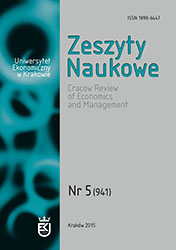Flexible Exchange Rates as Shock Absorbers in Central and Eastern Europe
DOI:
https://doi.org/10.15678/ZNUEK.2015.0941.0502Słowa kluczowe:
system kursu walutowego, SVAR, dekompozycja Blancharda-Quah, gospodarki transformacyjneAbstrakt
Tytuł artykułu: Właściwości amortyzacyjne płynnego kursu walutowego w gospodarkach Europy Środkowej i Wschodniej
Biorąc pod uwagę znane zalety kursu płynnego jako amortyzatora niekorzystnych wstrząsów makroekonomicznych, otrzymane rezultaty na podstawie modelu SVAR z dwoma zmiennymi sugerują, że oczekiwane teoretycznie korzyści od większej giętkości kursu walutowego nie są obserwowane dla Węgier i Rumunii, ponieważ więcej niż 80% zmienności nominalnego (realnego) kursu walutowego w obrębie roku jest wyjaśnione przez neutralny wstrząs strukturalny. Jednocześnie zmienność produkcji zależy głównie od własnych wstrząsów permanentnych. Świadczenia na korzyść stabilizacyjnych właściwości kursu walutowego są bardziej wiarygodne dla Polski i Czech (w mniejszym stopniu), gdzie od 30% do 40% zmian nominalnego (realnego) kursu walutowego można tłumaczyć permanentnymi wstrząsami ze strony sektora realnego. Otrzymane wyniki zależą jednak od wykorzystanych danych.
Pobrania
Bibliografia
Ahmed S., Gust C. J., Kamin S. B., Huntley J. (2002), Are Depreciations as Contractionary as Devaluations? A Comparison of Selected Emerging and Industrial Economies, International Finance Discussion Papers, no. 737, Board of Governors of the Federal Reserve System, Washington. DOI: https://doi.org/10.17016/ifdp.2002.737
Alexius A., Post E. (2008), Exchange Rates and Asymmetric Shocks in Small Open Economies, "Empirical Economics", 35(3), http://dx.doi.org/10.1007/s00181-007-0177-7. DOI: https://doi.org/10.1007/s00181-007-0177-7
Arratibel O., Michaelis H. (2014), The Impact of Monetary Policy and Exchange Rate Shocks in Poland: Evidence from a Time-varying VAR, ECB Working Paper Series, no. 1636, European Central Bank, Frankfurt am Main. DOI: https://doi.org/10.2139/ssrn.2385927
Artis M., Ehrmann M. (2006), The Exchange Rate: A Shock-absorber or Source of Shocks? A Study of Four Open Economies, "Journal of International Money and Finance", 25(6), http://dx.doi.org/10.1016/j.jimonfin.2006.07.003. DOI: https://doi.org/10.1016/j.jimonfin.2006.07.003
Aysun U. (2008), Automatic Stabilizer Feature of Fixed Exchange Rate Regimes, "Emerging Markets Review", 9(4), http://dx.doi.org/10.1016/j.ememar.2008.10.004. DOI: https://doi.org/10.1016/j.ememar.2008.10.004
Borghijs A., Kuijs L. (2004), Exchange Rates in Central Europe: A Blessing or a Curse?, IMF Working Paper, no. 4/2, International Monetary Fund, Washington. DOI: https://doi.org/10.2139/ssrn.878825
Canzoneri M., Valles J., Vinals J. (1996), Do Exchange Rates Move to Address International Macroeconomic Imbalances?, CEPR Discussion Papers, no. 1498, Centre for Economic Policy Research, London.
Chen S.-S. (2004), Real Exchange Rate Fluctuations and Monetary Shocks: A Revisit, "International Journal of Finance and Economics", 9(1), http://dx.doi.org/10.1002/ijfe.218. DOI: https://doi.org/10.1002/ijfe.218
Clarida R., Gali J. (1994), Sources of Real Exchange Rate Fluctuations: How Important Are Nominal Shocks?, "Carnegie-Rochester Conference on Public Policy", 41, http://dx.doi.org/10.1016/0167-2231(94)00012-3. DOI: https://doi.org/10.3386/w4658
Dibooglu S., Kutan A. M. (2001), Sources of Real Exchange Rate Fluctuations in Transition Economies: The Case of Poland and Hungary, "Journal of Comparative Economics", 29(2), http://dx.doi.org/10.1006/jcec.2001.1707. DOI: https://doi.org/10.1006/jcec.2001.1707
Erjavec N., Cota B., Jakšić S. (2012), Sources of Exchange Rate Fluctuations: Empirical Evidence from Croatia, "Privredna Kretanja i Ekonomska Politika", 132(1).
The Exchange Rate and Macroeconomic Adjustment (2003), HM Treasury, London.
Farrant K., Peersman G. (2006), Is the Exchange Rate a Shock Absorber or a Source of Shocks? New Empirical Evidence, "Journal of Money, Credit and Banking", 38(4). DOI: https://doi.org/10.1353/mcb.2006.0056
Gehrke B., Yao F. (2013), Sources of Real Exchange Rate Fluctuations: The Role of Supply Shocks Revisited, Beiträge zur Jahrestagung des Vereins für Socialpolitik 2013: Wettbewerbspolitik und Regulierung in einerglobalen Wirtschaftsordnung - Session: Applied Time Series, no. B20-V3, ZBW, Leibniz-Informationszentrum Wirtschaft, Kiel-Hamburg.
Juvenal L. (2009), Sources of Exchange Rate Fluctuations: Are They Real or Nominal?, Working Paper 2009-040B, Federal Reserve Bank of St. Louis, St. Louis. DOI: https://doi.org/10.20955/wp.2009.040
Kontolemis Z., Ross K. (2005), Exchange Rate Fluctuations in the New Member States of the European Union, Economics Working Paper Archive, no. 0504015.
López J., Chacón J. (2006), Following the Yellow Brick Road? The Euro, the Czech Republic, Hungary and Poland, Working Paper ECON, no. 06.12, Universidad Pablo de Olavide de Sevilla, Sevilla.
Masten I. (2002), How Important Is the Shock-absorbing Role of the Real Exchange Rate?, EUIWorking Paper, no. 2002/06, EEA, Venice.
Stążka A. (2006), Sources of Real Exchange Rate Fluctuations in Central and Eastern Europe - Temporaryor Permanent?, CESifo Working Paper, no. 1876, CESifo, München.
Stążka-Gawrysiak A. (2009), The Shock-Absorbing Capacity of the Flexible Exchange Rate in Poland. Focus on European Economic Integration, Oesterreichische Nationbank, Vienna.
Volha A., Brázdik F. (2012), Monetary Policy and Exchange Rate Dynamics: The Exchange Rate as a Shock Absorber, Working Paper Series, no. 9, Czech National Bank, Prague.
Pobrania
Opublikowane
Numer
Dział
Licencja
Prawa autorskie (c) 2015 Zeszyty Naukowe Uniwersytetu Ekonomicznego w Krakowie

Utwór dostępny jest na licencji Creative Commons Uznanie autorstwa 4.0 Międzynarodowe.

